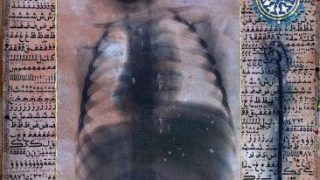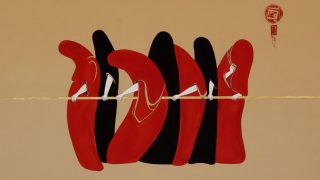Paris Hilton has found a footing in Mecca; Khadija Bint Khouwaylid, however, has lost her spot.
One day, an Arab poet tweeted: “I wander in Mecca’s streets looking for God; I did not find him in the holy mosque.” Consequently, fatwas were issued deeming her an apostate and calling for her to punished in accordance with religious law. The tweet was nothing but an old verse of poetry written by Jalal ad-Din Rumi, yet its echoes kept on tirelessly reverberating around the skies of Mecca.
The gleaming modern Mecca — with high-rise towers, a giant clock tower, markets rife with foreign brands, and western fashion houses — has become tired of its ancient history. It has taken off to skies other than its own, given its status as a city where Muslims from the four corners of the globe gather.
Months ago, the British daily The Independent published an article titled, "The photos Saudi Arabia doesn't want seen — and proof Islam's most holy relics are being demolished in Mecca." The shocking article included three photos showing digging operations within the mosque and mechanical diggers dismantling archeological columns inscribed with intricate Arabic calligraphy marking the phases of the Prophet Muhammad’s life. All of this has now become dust. The house of the prophet’s wife, Khadija Bint Khouwaylid, was transformed into public baths for pilgrims, while many other historical places from the era of the prophet and the early Islamic era were transformed into a market or library, or simply a marble-tiled floor.
These digging operations within the archeological sites of Mecca are being carried out under the title of expansion and enhancement of services, so the holy site can accommodate the millions of Muslims who visit the twin holy cities each year. The cost of the project is estimated at millions of dollars.
At first, Saudi Arabia did not respond to what was disseminated in the media or by archeological preservation organizations. Silence was the answer to any prompted question. The kingdom wants to sweep the issue under the rug, away from media interactions. Those of us who visit Mecca once in a lifetime would never notice what was demolished and what remained if it were not for the newspaper. What will catch our eye, however, is the upsurge of skyscrapers that tower over the grand mosque from all sides.
As a response to the mounting pressure in regard to dismantling Mecca’s oldest neighborhoods, the Grand Mufti of Saudi Arabia, Sheikh Abdul-Aziz al-Sheikh, permitted the demolition of monuments under the pretext of expanding the two holy mosques.
“We do not object to the demolition of monuments in the two holy mosques, rather it is crucial,” said Sheikh. Ironically, this statement came as part of a conference titled, “Reasons behind the disintegration of families and mechanisms for a solution.” Sheikh considered the expansion projects as “decent work the state should be thanked for. It is a necessity. If it were not for the expansion, pilgrimage wouldn’t be accessible for millions of people. These [expansion works] are legitimate.”
With the emergence of such a religious cover that permitted moving forward with the project, two opinions surfaced within the kingdom. The first sees that [the works] are in the best interest of Muslims, considering the preservation of monuments as a bizarre demand that must not be reflected upon. The second opinion calls on filing a petition to the king to demand the halt of demolition that is affecting many historical sites. Supporters of this view believe that the expansion process can be executed without destroying [historical sites] and that Mecca has become infested with skyscrapers and towers, which are dragging the city away from the religious aspect that it is known for.
Yet this is not a first. Saudi Arabia has demolished historical monuments and sites in the past. This issue is often linked to Wahhabi doctrine followed by the kingdom, which prohibits journeying to shrines, as it is seen as a form of idolatry. In 1952, the state has destroyed Al-Baqi cemetery, where the daughter, wives and companions of the prophet are buried.
In 2002, the kingdom demolished a Turkish fortress that was built in the eighteenth century on a hill overlooking the Kaaba. Both the hill and the fortress were removed in order to make room for construction projects in the vicinity of the mosque. The demolition of Turkish monuments inside and nearby the mosque ushered in tense relationship between the kingdom and Turkey. The Turkish minister of culture described the expansion works at the time as “barbaric.”
As usual, twitter accounts in Saudi Arabia have been teeming with opinions about this hot topic, which is the demolition of monuments in Mecca. Reactions range from mockery to support for the expansion projects. “Since there has been a fatwa and expansion takes place each year, we welcome, then, the residents of Mecca in al-Medina.” ... “These monuments are supposed to be priceless for all Muslims, they are not related to fatwas. Solutions must be found in order to protect them.” ... “This decision is correct and is being objected to by those who have only seen the mosque in photos. Therefore, [they think] it does not need expanding.” ... “What about skyscrapers? Or maybe there are some limits the fatwa cannot cross.” ... “Performing Hajj is more important and is mentioned in the Quran. Pilgrimage is a pillar of Islam and thus comes before the monuments.”
The city of Medina and al-Masjid al-Nabawi are also undergoing expansion and enhancement projects that are believed by many to be a way of obliterating Islamic monuments that the authorities do not want seen, as they have done in the past. The petition we received via email was not about halting the digging operations under the al-Aqsa mosque in Palestine, but those being carried out in Mecca, particularly inside the holy mosque. The mosque comprises historical sections such as the Kaaba, the Qibla — which is considered to be one of the most important holy sites — in addition to the now-demolished historical monuments that are said to document the Mi’raj journey of the Prophet.
During the last decade, Mecca’s features have been altered. Nearly 95% of its millennium-old architecture is gone. Modern buildings were constructed around the mosque, the most prominent of which is probably the clock tower that has been likened to London’s Big Ben. The tower consists of a 120-story hotel. Additionally, the Abraj al-Bait is considered one of the world’s largest skyscrapers in terms of square footage.
The beautification scalpel has distorted the face of the city. It has maybe produced a modern, appealing-to-the-eye view, but it has definitely eradicated the essence and soul of the place. Mecca can no longer take us back in time to the era when our prophet walked its streets. We are now concerned, as one of the tweets states, about [the potential for] fatwas permitting the demolition of the Kaaba and the Cave of the Patriarchs to accommodate the pilgrims that are coming to perform their rituals.
Translated by Al-Monitor



